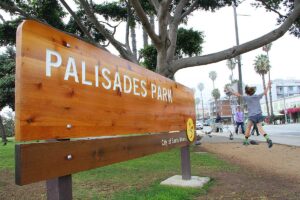
ANCIENT SANTA MONICA — The 1914 City Council would have felt a kinship to their political descendants of 2014. A hundred years ago this month, council opted to discuss restrictions in Santa Monica's parks.
A century before this council decided to regulate fitness trainers in the parks, that council proposed an ordinance that would prohibit the public from "picking flowers, swearing, drinking liquor, playfully exploding fire-crackers, toy pistols, and other noise-producing instruments" at the parks, according to the Los Angeles Times archives.
The ordinance would "keep the rough element away" and create peace and comfort for the woman and children who visit the parks. We wonder how they would have felt about stereos and free-weights.
And the struggle with events on the Santa Monica Pier is nothing new for City Hall, either. Last month, at the recommendation of City Hall, council voted to downsize the free summer concerts at the pier, fearing that the popularity was causing a safety hazard. In 2013, public safety officials got nervous after a Jimmy Cliff concert drew an estimated 20,000 to 30,000 people to the beach. In February 1914, all it took was one woman doing the tango.
A Los Angeles Times article entitled "Danced tango on pier" gives a detailed account of the uproar that occurred when Mary Malgousier danced tango on the pier.
Added to the fact that tourists began to gather around the "handsome young woman," was the fact that it was Sunday and council had recently banned the tango on the Sabbath.
She danced "with great grace and nerve and no one ventured to stop her until Officer Harding arrived."
Harding apparently hesitated, balancing his "admiration" with his sense of duty and the "proper regard for the peace and dignity of the strand" before threatening to arrest her.
"The ordinance do not allow such dancing in a public place," he said in a firm voice, according to the Times' archive.
Boys and girls danced all summer long on the beach and in the dancing pavilions, the Times noted, and the legality of tangoing had not yet been questioned.
"Whether the fact that a good-looking woman dances on the pier constitutes a breach of the law still remains to be tested in court," the article concluded.
Businesses licenses were an issue back then as well. Police recommended that all those that applied to work as fortune tellers, clairvoyants, and mediums must be able to give a good account of their past history. The chief of police personally investigated all of the soothsayers.
"The city does not desire to have the beach front infested by fakers," the Times article said.
Big race month
While modern Santa Monicans watch the Olympics hoping their favorite athletes don't turn an ankle in Russia, a century ago the big sporting event — the Vanderbilt Cup car race — was held in the city by the sea and a turned ankle was the least of their worries.
In one race, a driver lost control of his car and plowed through the wall of the old Soldiers' Home killing a Civil War veteran. The driver was hurt but survived to race later in the week.
The races gave the cops a headache trying to catch residents imitating their favorite drivers on the course (the streets of Santa Monica) before the races started. At one point rains harmed the "Death Curve" (the corner of Wilshire Boulevard and Ocean Avenue) but thankfully it was revived.
Old cottage
Santa Monica Conservancy members might want to plug their ears for this next bit as it'll likely make them sad. Even in the past, there were those who had no regard for the past: A house built in 1891 was plowed over 100 years ago this month.
State Senator John P. Jones, co-founder of Santa Monica, owned the plot on the Soldiers' Home land but sold it to a professor. After the professor died, his daughter sold the cottage and it was torn down.
School lunches
Santa Monica High School students went on a hunger strike a century ago to protest the rising cost of ice cream in the cafeteria. Prices doubled! (from 5 cents to 10 cents). Also the size of cake (5 cents) was halved.
They could stand the cost increases on "staple food" the Times reported, "but they balked at the increased cost of the pastry and frozen confection."
The nerve of those school officials.
dave@www.smdp.com








